Electric buses in London
Welcome to my guide to electric buses in London.
Transport for London is currently trialing loads of different types of electric buses because the air quality in London has got very bad recently. The aim is for all buses entering Zone 1 to be electric. TFL has previously trialed hybrid buses to trail out the technoligy and ultimatly deciding which buses to order on mass (the winners were Volvo i-shit and Enviro 400 H BAE), now TFL is doing the same thing with electric buses (and BYD Electric is looking likly to be the winner). TFL are pushing ahead with electric bus orders to reduce pollution levels, but I personally don't think they are acting fast enough.
At the 2017 bus expo at the NEC in Birmingham, bus operators were talking about how getting the electric supply to the bus depots is just as expensive at the buses themselvs.
The technoligy being developped is not the buses themselves, but the batteries needed. BYD from china are outperforming pretty much every other company with both the batteries and there buses.
Citaro Hydrogen (2004)
Before battery electric buses starting being trialled, hydrogen-electric buses have been tested. The first hydrogen buses were Mercedes-Benz Citaros and entered service in 2004. These only lasted a couple of years before being withdrawn (The reason why is unknown). They ran on route RV1, which today is again running hydrogen buses. Sadly, I never went on one of these. (one of them is currently stored at Acton depot museum).
The concept of a hydrogen-electric bus is simply an electric bus using hydrogen as the power sorce. Effectivly hydrogen is being used as a battery. The hydrogen is produced in a factory using electrolysis (splitting water using electricity). The hydrogen is delivered to the bus depot where it is put into the buses. The buses burn the hydrogen back into water to produce elctricity. This removes emmisions from London's streets (which is the main priority) but it does not help with climate change overall. Hydrogen is very inefficent as the amount of electricity used to produce the hydrogen is much greater than the amount of electricity the bus generates from burning it.
Date: 2004 (withdrawn: 2007?)
Max Speed: ???
Max Acceleration: ???
System: ???
Number in service: none (was ???)
Max Speed: ???
Max Acceleration: ???
System: ???
Number in service: none (was ???)

Here are some rare pictures of this bus taken by citytransportinfo (public domain)


Wrightbus Hydrogen (WSH) (2010)
Hydrogen buses returned in 2010 when TFL. They make a very strange sound (the sound consists of an electric motor plus the sound of the hydrogen generator makes a very unusal sound.). These run on route RV1 which goes along the south bank of the Thames and goes across Tower Bridge (the same route as the original hydrogen-electric buses).
In 2013, 3 more buses were brought, making a total of 8 buses. The 3 new buses have series 1 styling to match the other buses rather than using Wrightbuses (then) current series 2 styling (which I am disapointed about).
UPDATE: In 2019 TFL removed the RV1 route and these buses have been moved to the 444 route along the north cirular which is a very fast road and is completly inapropriate for these buses.
Date: late 2010 and 2013
Max Speed: 30mph
Max Acceleration: 2 mph/second
System: CHIC
Number in service: 8
Max Speed: 30mph
Max Acceleration: 2 mph/second
System: CHIC
Number in service: 8








BYD Electric bus prototypes (2013)
In 2013 Transport for London started the electric bus trials. These were the first fully electric buses in London.
The BYD (Build Your Dreams) bus from China was the first electic bus to enter service in London. There were 2 BYD buses in London which ran on route 507 from Victoria to Waterloo. These 2 buses were totally awesome and make a great sound. These ran for a trial for 1 year and the trial was very sucsessfull. After the trial they were replaced with prototype BYDs with Enviro 200 bodies (I will come to this later)
Date: late 2013
Max Speed: 30mph
Max Acceleration: 3 mph/second
System: BYD Electric
Number in service: none (was 2)
Max Speed: 30mph
Max Acceleration: 3 mph/second
System: BYD Electric
Number in service: none (was 2)







Optare Metrocity Electric (2014)
Optare's new fully electric buses as part of the electric bus trial. These run in south London. The Optare MetroCity is Optare's new design of bus (and is similar to the Optare Versa). These buses look very nice and have a good interior. The performance of these buses is fairly ok. They accelerate well but very quickly loose power. Their top speed is 30 mph. There are 9 of these buses, plus an adition 10th bus brought in 2015, but not many seem to be in service at once.
Date: 2014
Max Speed: 30mph
Max Acceleration: 2.5 mph/second
System: Optare Electric
Number in service: 9
Max Speed: 30mph
Max Acceleration: 2.5 mph/second
System: Optare Electric
Number in service: 9






Irizar electric bus (2015)
This is the third type of bus brought in for the bus trials. These buses are good all rounders.
All 3 types of electric bus sound great and run very well, and have very similar performance (acceleration and speed). The BYD is the most quirky with the best motor sound, the Optare is most well known and runs well, the Irizar is an all rounder but has poor battery performance. At this point it was looking very close for which bus would win.
I might be imagining it but the Irizars don't seem to be in service as often as the others. I had a very interesting conversation with a guy from BYD at the 2017 bus expo at the NEC in Birmingham. He was saying that the Irizar would never be a major condender as its battery technology was miles behind the others. We recorded this conversation.
These buses originally ran on the 507/508 routes in the center of London but were then moved to the 108 route which runs through the Blackwall Tunnel.
Date: 2014
Max Speed: 35mph
Max Acceleration: 2.5 mph/second
System: Irizar Electric
Number in service: 2
Max Speed: 35mph
Max Acceleration: 2.5 mph/second
System: Irizar Electric
Number in service: 2



BYD Double Deck (2016)
These are the world's first Battery electric double deck buses. These buses are awesome. To my amazement, these buses have really good acceleration, in fact, these are the fastest buses in the whole of London. They pull away ar 4.5 mph/sec and take just 9.5 seconds to reach 30 mph. It is amazing how a large double deck bus, that isn't the slightest bit slow, can be entirely battery powered, and these run on the 98 route which is a long major route. This really shows the future of buses. China is normally thought of as low quality manufacturing who produce rip offs of other companies products, it is amazing that chinese companies are now inovating new products and achieving things that other companies havn't been able to. The only thing that is disappointing is that they don't look that great compared to the styling of other manufacturers.
Date: 2016
Max Speed: 45mph
Max Acceleration: 4.5 mph/second
System: BYD Electric
Number in service: 5
Max Speed: 45mph
Max Acceleration: 4.5 mph/second
System: BYD Electric
Number in service: 5




BYD Enviro 200 (2016)
The new electric Enviro 200s using BYD's (not to be confused with BAE) electric system. These buses run very well, they run and sound exactly the same as the original BYD electric buses.
These are the second prototypes of BYD electrics which started permantly running on the 507/508 routes after the trial of the original BYDs ended.
Having BYDs with Enviro bodies is a very good combination and works very well.
Date: 2016
Max Speed: 30mph
Max Acceleration: 2.5 mph/second
System: BYD Electric
Number in service: 10
Max Speed: 30mph
Max Acceleration: 2.5 mph/second
System: BYD Electric
Number in service: 10





The production buses (2017 - 2019)
These buses left their prototype stage and entered production in 2017 (This is the first type of electric bus to go into full production). Their first route is the 360, and these buses are going to replace every single deck bus route that enters zone 1. These buses are very simular to the prototypes, but are missing some of the futuristic info screens and styling. It is quite typical for prototypes to go full on futuristic, but many features are left out in production due to cost. BYD are doing very well in the electric bus trials so far.
Date: 2017
Max Speed: 30mph
Max Acceleration: 2.5 mph/second
System: BYD Electric
Number in service: loads coming soon
Max Speed: 30mph
Max Acceleration: 2.5 mph/second
System: BYD Electric
Number in service: loads coming soon


Updated design (2020 - present)



Enviro 400 VE Inductive Charging (2016)
This is a range extended electric bus. This uses the BAE hybrid system but has larger batterys. The batterys are charged at the ends of the bus route using inductive charging, which allows the bus to run without the engine for a while. The bus charges through an electromagnetic field, which is effectivly a split transformer. There is a charging section in the floor of the bus station, which acts as half of a transformer, the other half is in the bus. The bus charges wirelessly, this is far more partical but is not very efficent because of the gap that the electromagnetic field has to cross.
In practise the system doesn't work that well. The hybrid system itself works perfectly as it is the BAE system (the best of all the hybrid systems). But for an electric bus it fails because it takes too long to charge, buses are regularly driven off with very little charge and go a very short distance before the engine has to start generating. These buses run on the 69 route from Walthamstow to Canning town.
On the side of the bus it says it runs mainly in electric mode. This isn't true, it mainly runs in diesel generator mode. Also the promotional infomation says they are the worlds first electric double decks which isn't true as they were just beaten by BYD.
Date: 2016
Max Speed: 60mph
Max Acceleration: 4 mph/second
System: BAE with large batterys and inductive charging
Number in service:
Max Speed: 60mph
Max Acceleration: 4 mph/second
System: BAE with large batterys and inductive charging
Number in service:




Wrightbus StreetAir (2017)
This is a prototype wrightbus that is being trialled on route 360. The major manufacturers usually seen in the UK are being left behind when it comes to electric buses.
This bus has the same motors as the Boris buses. This bus did not run for very long, it's batteries did not perform as well as it's rivals. This is disapointing for a major manufacture in these very competitive trials.
Date: 2017
Max Speed: 35mph
Max Acceleration: 2.5 mph/second
System: Seimens
Number in service: 1
Max Speed: 35mph
Max Acceleration: 2.5 mph/second
System: Seimens
Number in service: 1



BYD electric production bus prototype (2017)
This is production version of the BYD with BYD's own bodywork. This is effectivly a final prototype of a production version of the BYD single deck but with BYD's own bodywork. Zero orders were taken of this bus, with all bus operators going for the Enviro 200 version.
Date: 2017
Max Speed: 30mph
Max Acceleration: 2.5 mph/second
System: BYD Electric
Number in service: 1
Max Speed: 30mph
Max Acceleration: 2.5 mph/second
System: BYD Electric
Number in service: 1

Optare MetroDecker prototype (2017)
This is a prototype bus from Optare being trialled on the 36 route from New Cross to Queens Park.
This is London's second type of fully electric double deck bus. This is the rival to the BYD double deck, but it is hardly a rival. The BYD is fast and epic and works really well. This Optare MetroDecker is pathetic by comparison. The only good thing about it is its styling, the actual performance of this bus is completely pathetic.
Date: 2017
Max Speed: 30mph
Max Acceleration: 2 mph/second
System: BYD Electric
Number in service: none (was 1)
Max Speed: 30mph
Max Acceleration: 2 mph/second
System: BYD Electric
Number in service: none (was 1)




Yutong prototype (2018)
Yutong is a rival chinese bus company. They want to enter the UK market. This bus is entirely built by Yutong and uses no bought in parts, which gives a rather unusual feel to it and some parts look very odd. This bus feels very much of a chinese company copying everything they think a bus needs to try to get it to sell in England. These buses are very hard to maintain unless a company has bought a massive fleet of at least 100 buses, due to every part of the bus (down to every little detail) being proprietary. There have been reports of these buses not lasting very long, but it is too early days to know if this is true or not. It is unlikly that Yutong will be able to sell their electric buses in the UK.
Date: 2018
Max Speed: 30mph
Max Acceleration: 2.5 mph/second
System: Yutong
Number in service: 1
Max Speed: 30mph
Max Acceleration: 2.5 mph/second
System: Yutong
Number in service: 1

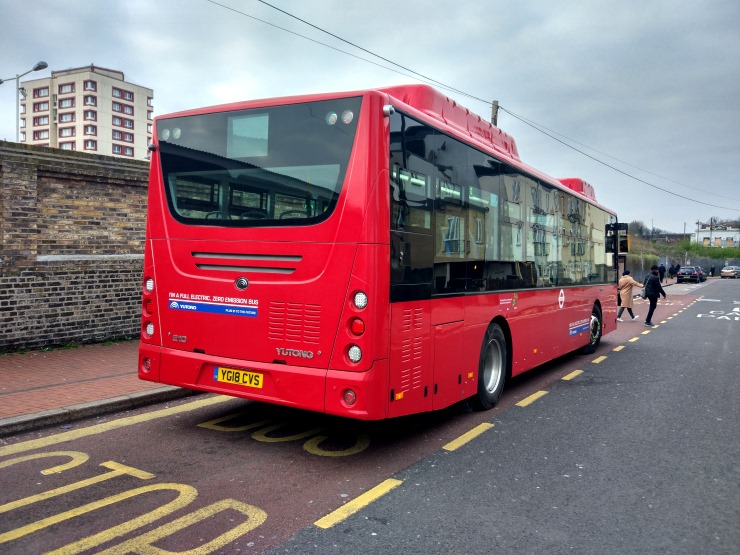

VanHool Hydrogen (2018)
New Hydrogen buses by VanHool. These have much better acceleration than the Wrightbus hydrogens. These use the same hybrid system as the Boris buses. Rather than generating electricity as an when needed, it generates electricity all the time. This ruins the batterys quicker (as there are no clean charge cycles), but on a hydrogen bus this system has an advantage. As hydrogen can't generate electricity quickly, this system allows a charge to be built up which gives the bus a boost of power when needed.
Date: 2018
Max Speed: 40mph
Max Acceleration: 3 mph/second
System: VanHool hydrogen
Number in service: none (was 2)
Max Speed: 40mph
Max Acceleration: 3 mph/second
System: VanHool hydrogen
Number in service: none (was 2)

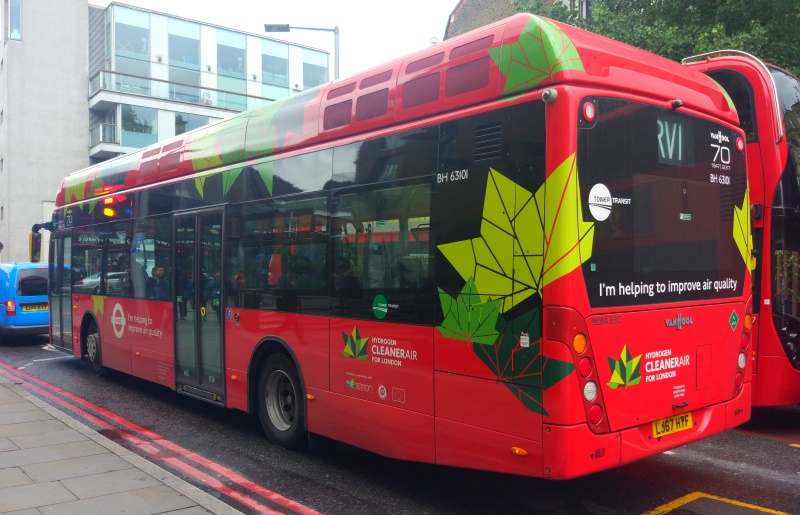

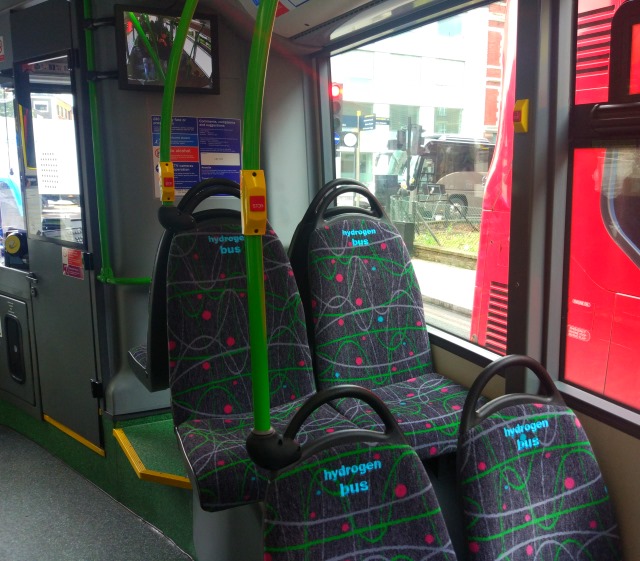

In 2019 the RV1 tourist route was cut. Both the wrightbus and VanHool hydrogen buses now run on the 444 route along the north cirular which is a very fast road and is completly inapropriate for these buses.

BYD Enviro 400 city (2019)
Once the BYD Enviro 200s came out it was pretty obvious that they were working on the BYD Enviro 400, and it was also pretty clear that BYD were well in the leed for winning the electric bus trials. BYD's electric busses have by far out performed their rivals.
The allience between BYD and Alexander Dennis is more than just a bus parts deal, it is full partnership between the two companies. and the bus was jointly by both companies. Also it is an exclusive partnership with the aim of out compoeting Alexander Dennis's biggest rival Wrightbus.
So how does the BYD Enviro 400 perform? It runs much more smoothly than all previous electric buses. It is very refined and a lot of effort has been put in to perfecting it. It uses the premium city version of the new enviro which features nicer styling and a glass staircase.
But to my massive disappointment the bus does not have the phenomenal acceleration of the prototype BYD double deck. It also has a very quiet motor sound, which is a bit dull.
Another interesting feature is that it has cameras instead of wing mirrors. Also, unlike Wrightbus, the upstairs has full sized windows which is nice.
Date: 2019 - present
Max Speed: 46mph
Max Acceleration: 3 mph/second
System: BYD
Number in service: Going to be loads
Max Speed: 46mph
Max Acceleration: 3 mph/second
System: BYD
Number in service: Going to be loads
Regular version
This is the standard Enviro city design with glass windows where the staircase is.








Alternative version
This version does not have the glass staircase, but instead has a glass skylight on the roof.
As for the interior of the bus, it has the most modern and futuristic interior that I have ever seen on a London bus.






Caetano Electric (2020)
Date: 2020
Max Speed: 40mph
Max Acceleration: 3 mph/second
System: Siemens
Number in service: Going to be loads
Max Speed: 40mph
Max Acceleration: 3 mph/second
System: Siemens
Number in service: Going to be loads
These use Siemens motors




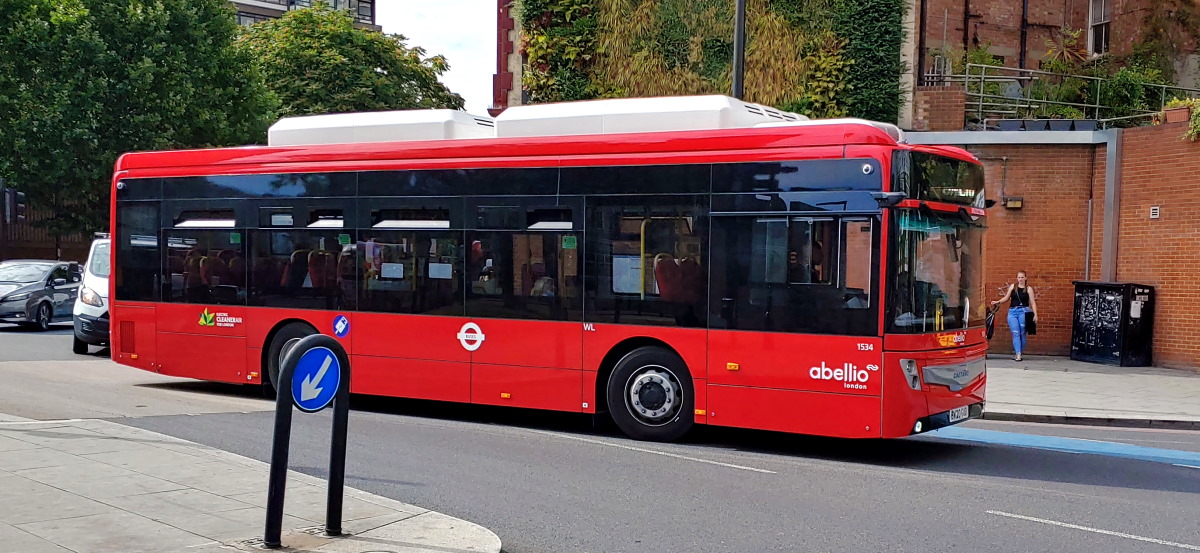
Wrightbus Streetdeck Hydroliner(present)
Date: 2022 - present
Max Speed: 30mph
Max Acceleration: 3 mph/second
System: Siemens
Number in service:
Max Speed: 30mph
Max Acceleration: 3 mph/second
System: Siemens
Number in service:


Wrightbus Streetdeck Electroliner(2022 - 2024)
After doing very badly in the electric bus trials, Wrightbus (now owned by JCB) have started producing double deck electric buses. These use Siemens motors, which they have used for many years, starting with the Boris buses.
Date: 2023 - present
Max Speed: 46mph
Max Acceleration: 3 mph/second
System: Siemens
Number in service: Going to be loads
Max Speed: 46mph
Max Acceleration: 3 mph/second
System: Siemens
Number in service: Going to be loads


Wrightbus Streetdeck Electroliner updated version(2024 - present)
Date: 2024 - present
Max Speed: 46mph
Max Acceleration: 3 mph/second
System: Siemens
Number in service:
Max Speed: 46mph
Max Acceleration: 3 mph/second
System: Siemens
Number in service:



MCV Volvo BZL single deck (2024)
While Volvo did not participate in the bus trial, they are now producing electric buses for London. Volvo electric buses are very popular in europe, although most of them abroad are short range electric buses which have to be charged every time they run the length of a route. This would not be possible in London as charging time has to be factored into the timetable. Volvo are relatively at producing long range electric buses.
These buses have 2 gears (which is not normal for an electric bus), they have an i-shift gearbox which has to fully disengage the engine to change gear (simular to the B5LH hybrids).
Date: 2024 - present
Max Speed: 46mph
Max Acceleration: 3 mph/second
System: Volvo
Number in service:
Max Speed: 46mph
Max Acceleration: 3 mph/second
System: Volvo
Number in service:




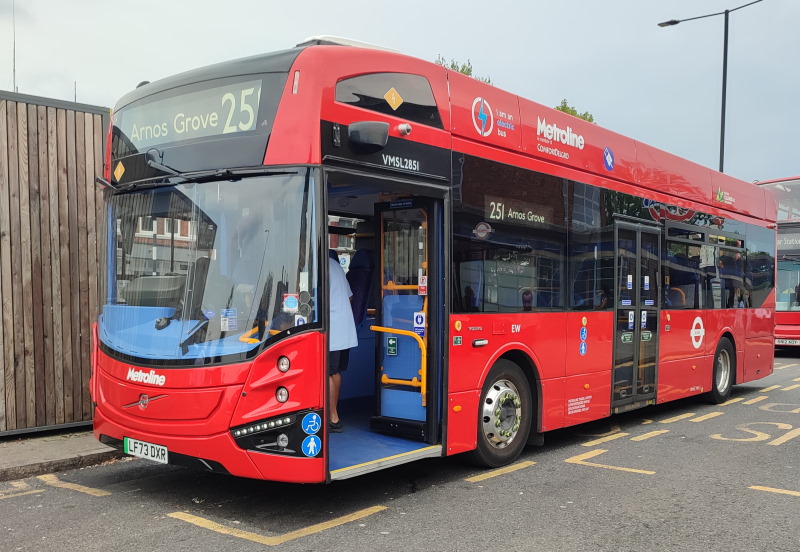


MCV Volvo BZL double deck (2024)
Date: 2024 - present
Max Speed: 46mph
Max Acceleration: 3 mph/second
System: Volvo
Number in service:
Max Speed: 46mph
Max Acceleration: 3 mph/second
System: Volvo
Number in service:


BYD double deck production bus (2024 - present)
Date: 2024 - present
Max Speed: 46mph
Max Acceleration: 3 mph/second
System: BYD
Number in service:
Max Speed: 46mph
Max Acceleration: 3 mph/second
System: BYD
Number in service:
Irizar ieTram(2024)
Date: 2024 - present
Max Speed:
Max Acceleration:
System: Siemens
Number in service:
Max Speed:
Max Acceleration:
System: Siemens
Number in service:
Yutong double deck prototype (2024)
Date: 2024
Max Speed:
Max Acceleration:
System: Yutong
Number in service:
Max Speed:
Max Acceleration:
System: Yutong
Number in service:
THE END
I hope you have enjoyed reading this guide!
Further reading...
See the hybrid buses in London.See more of my bus guides
Find out the current location of a London bus
Go to the BENO homepage